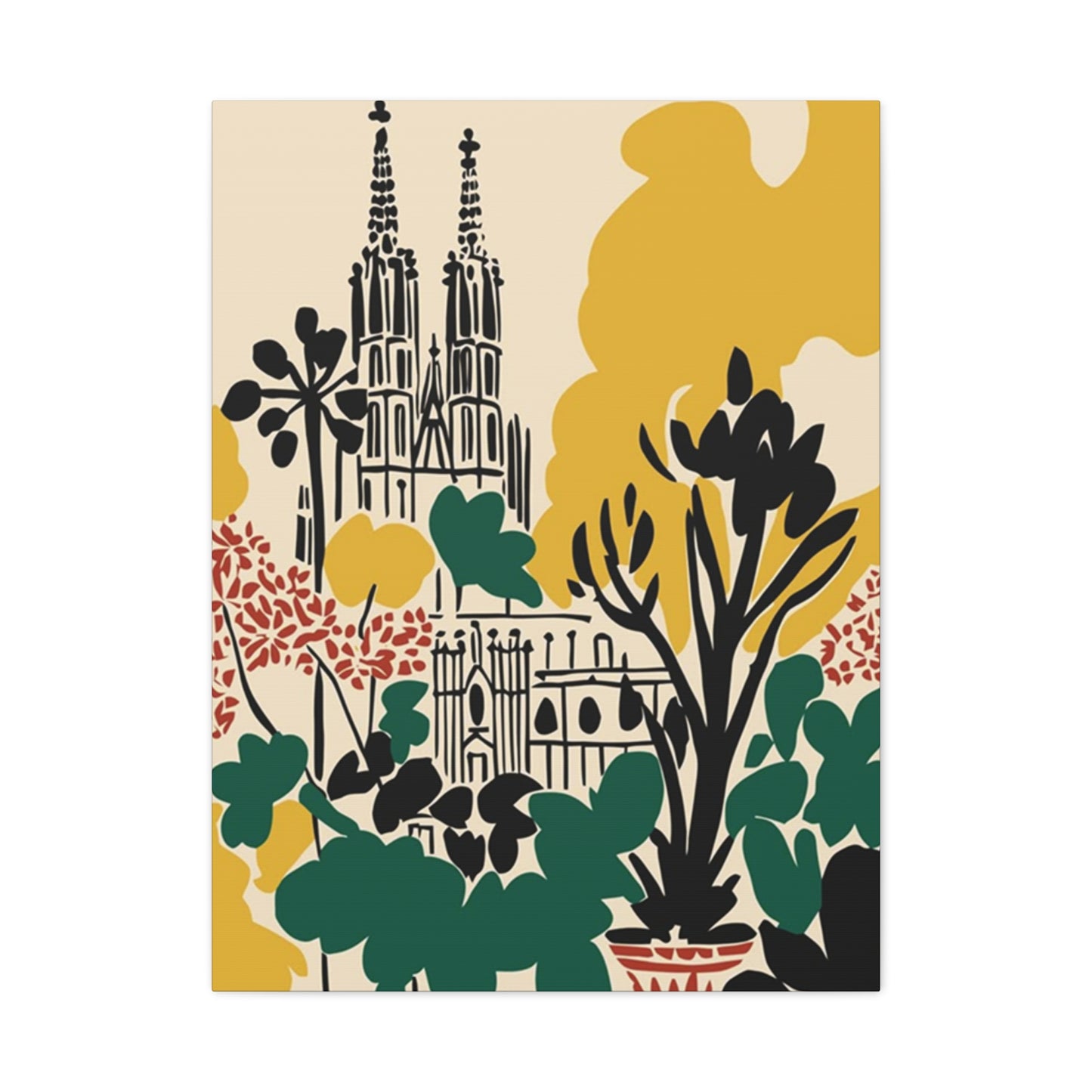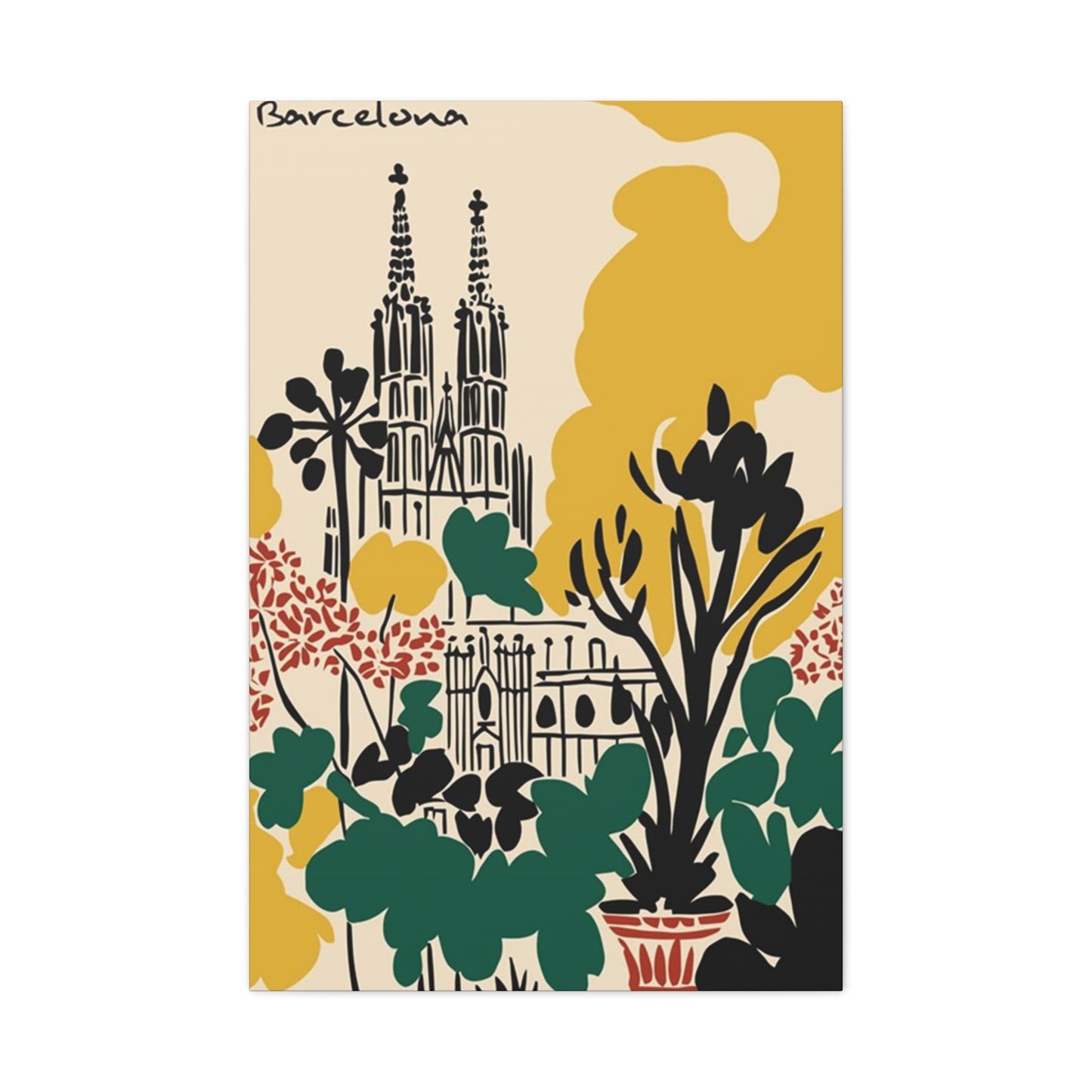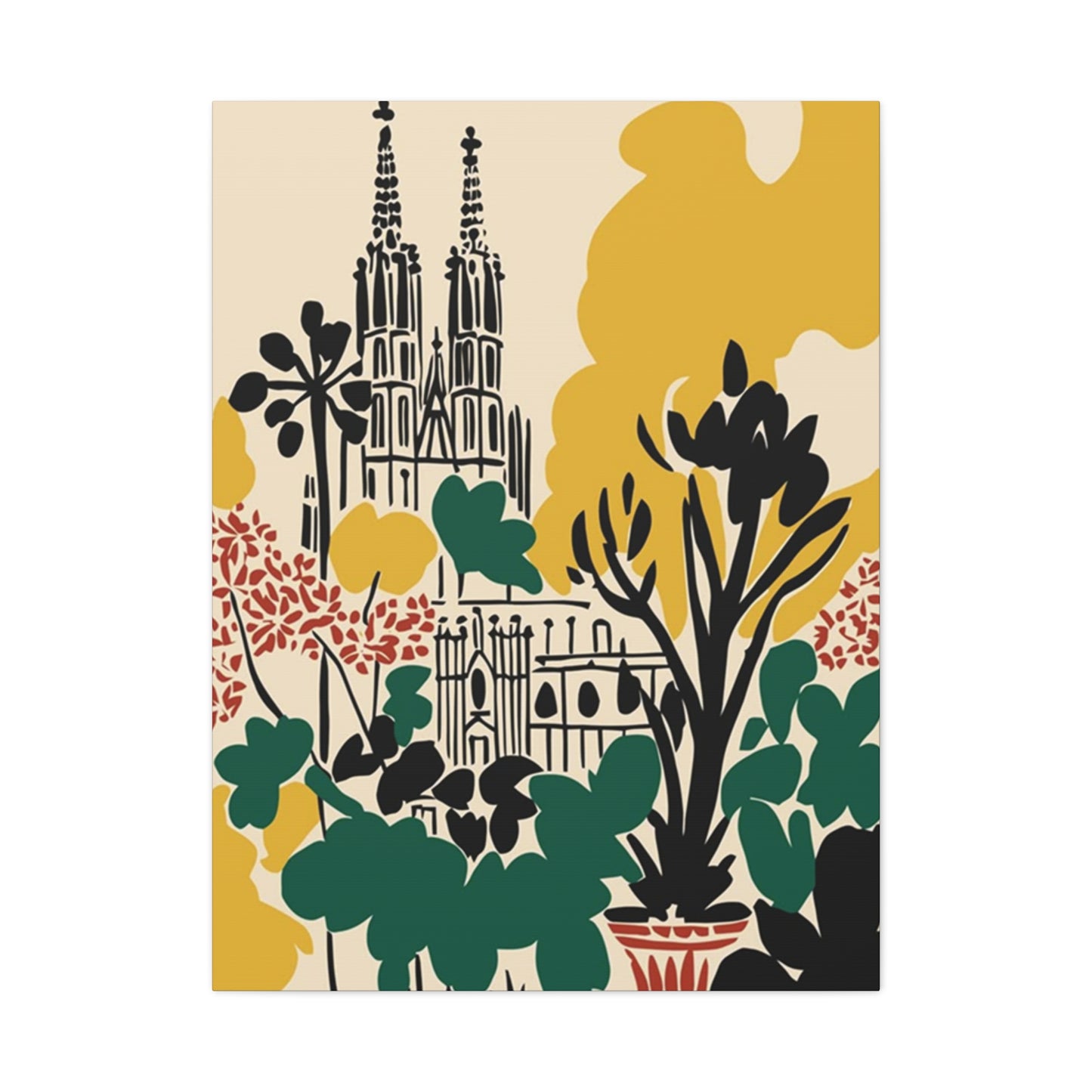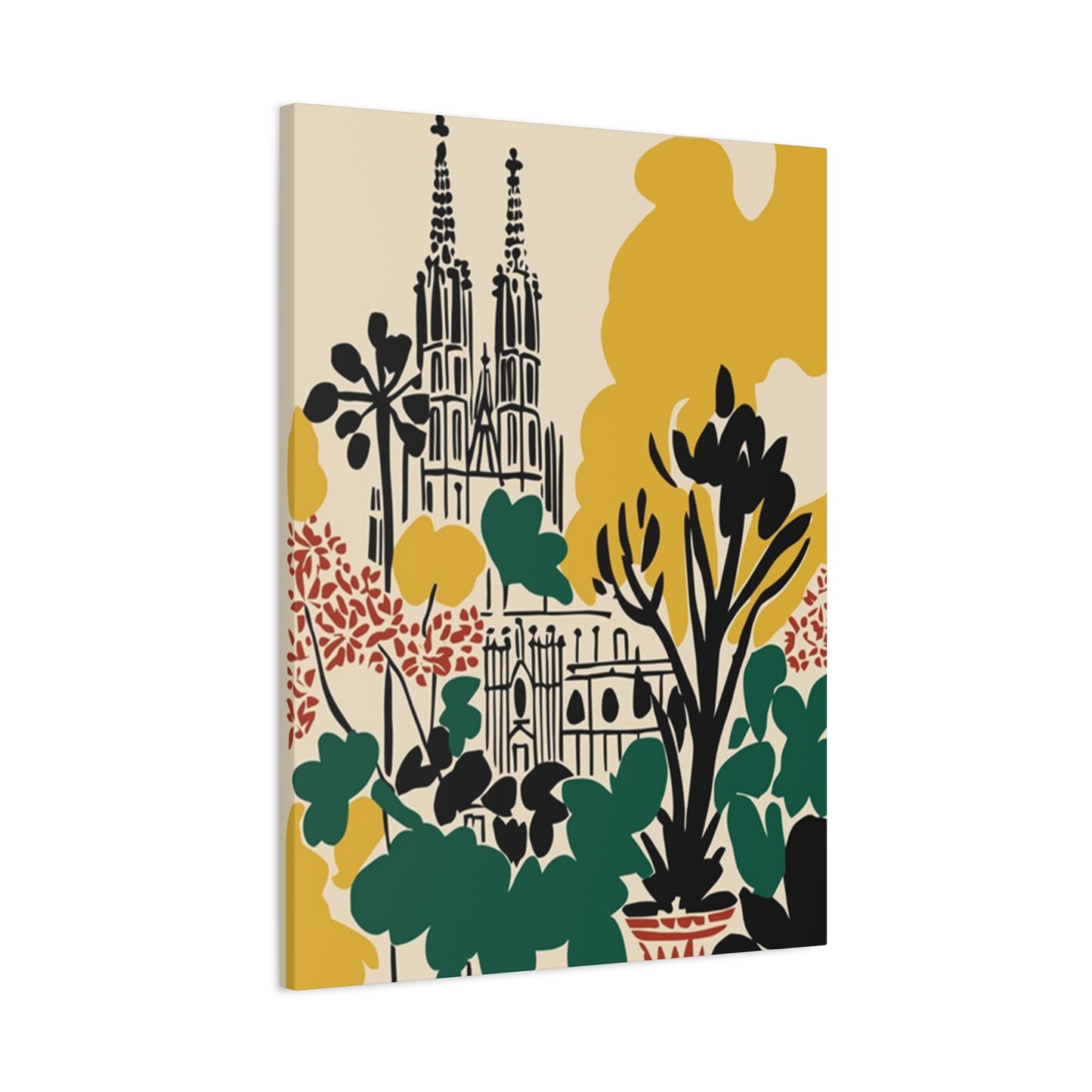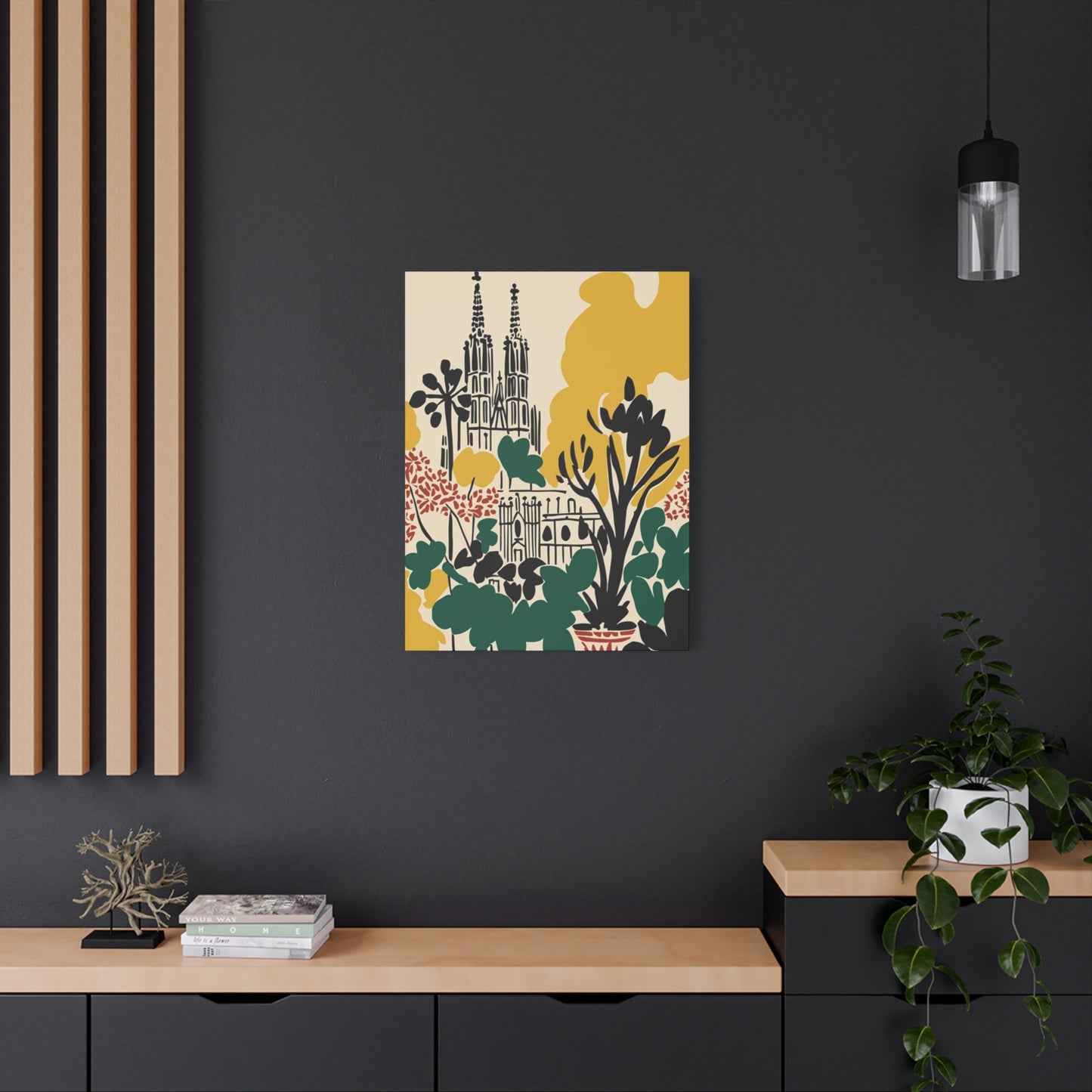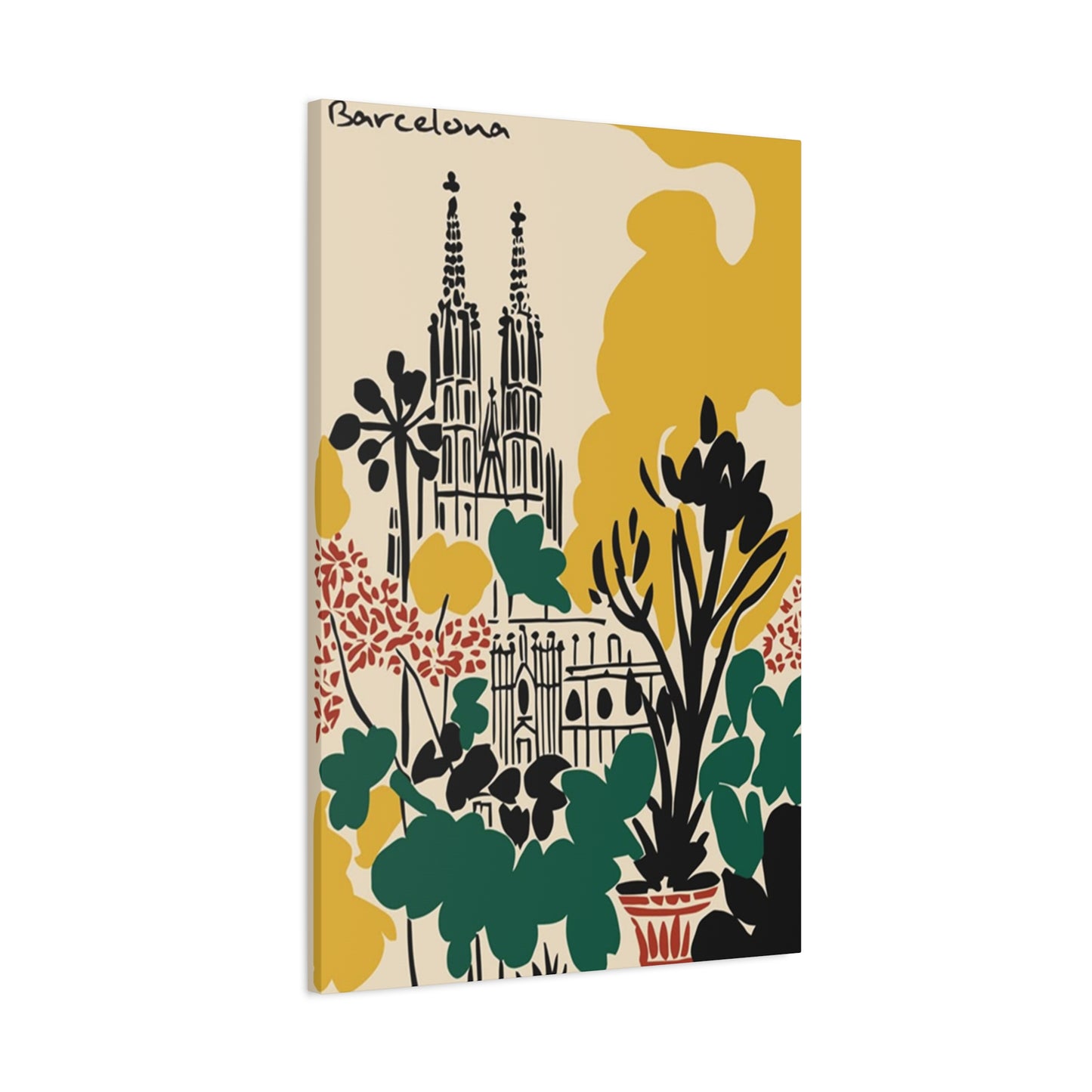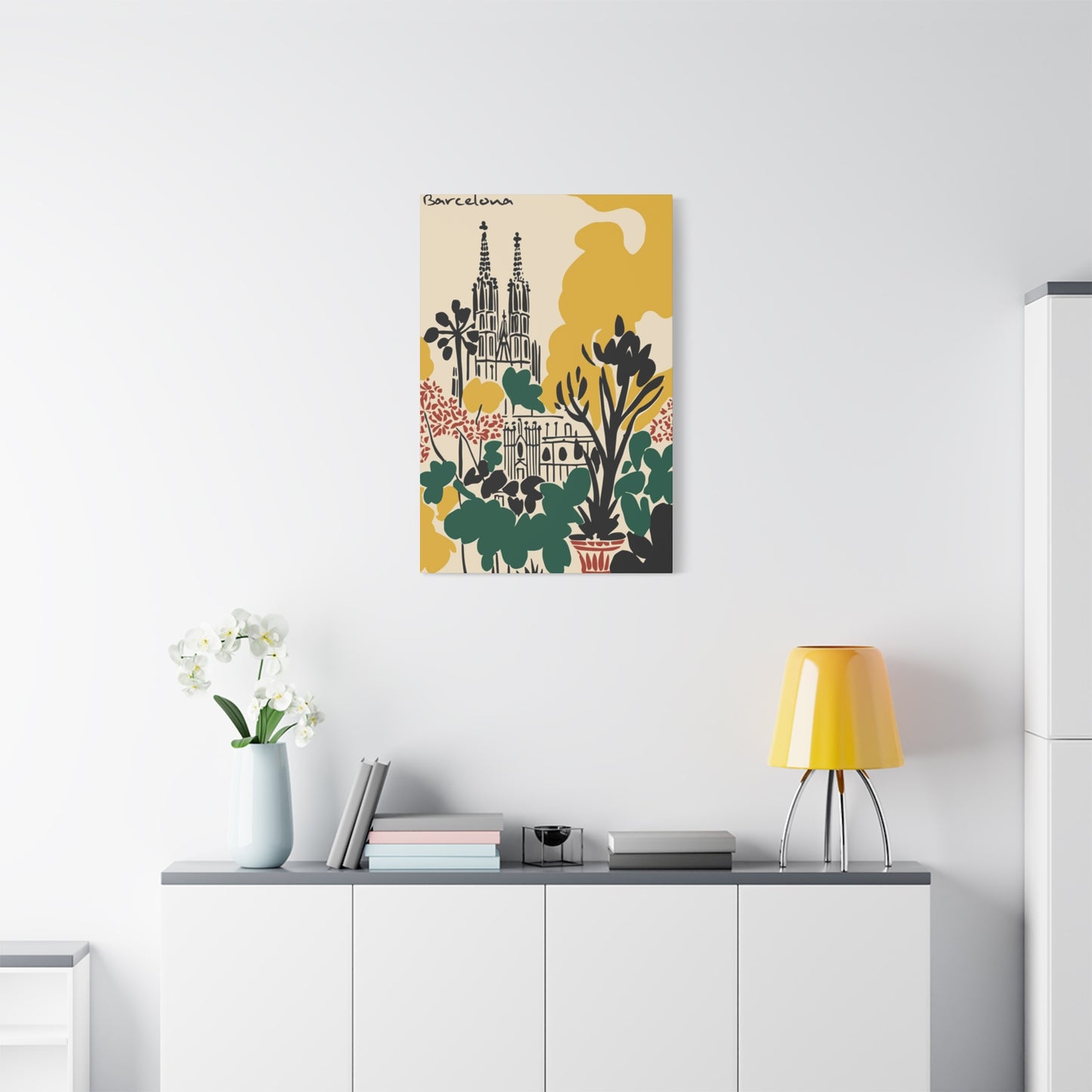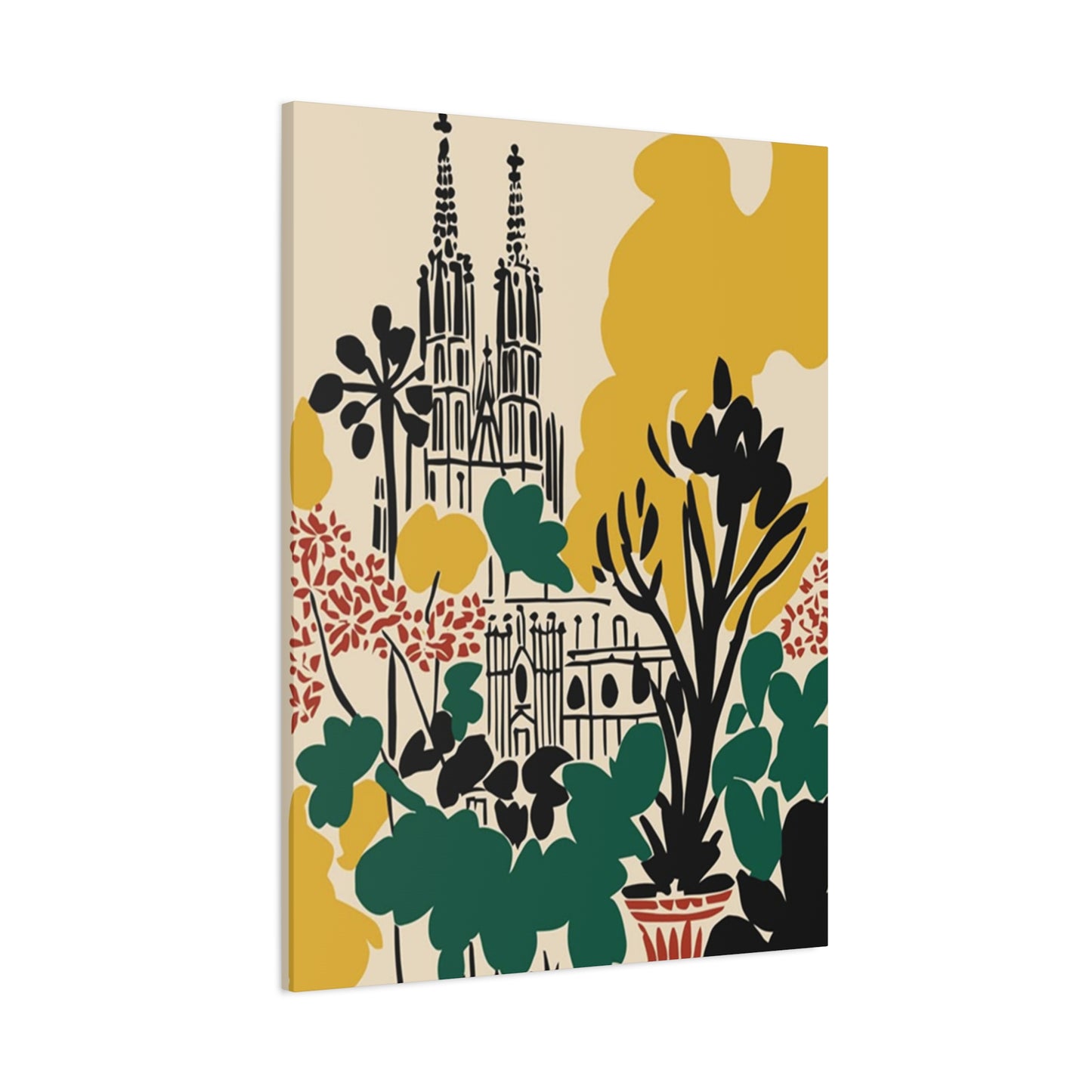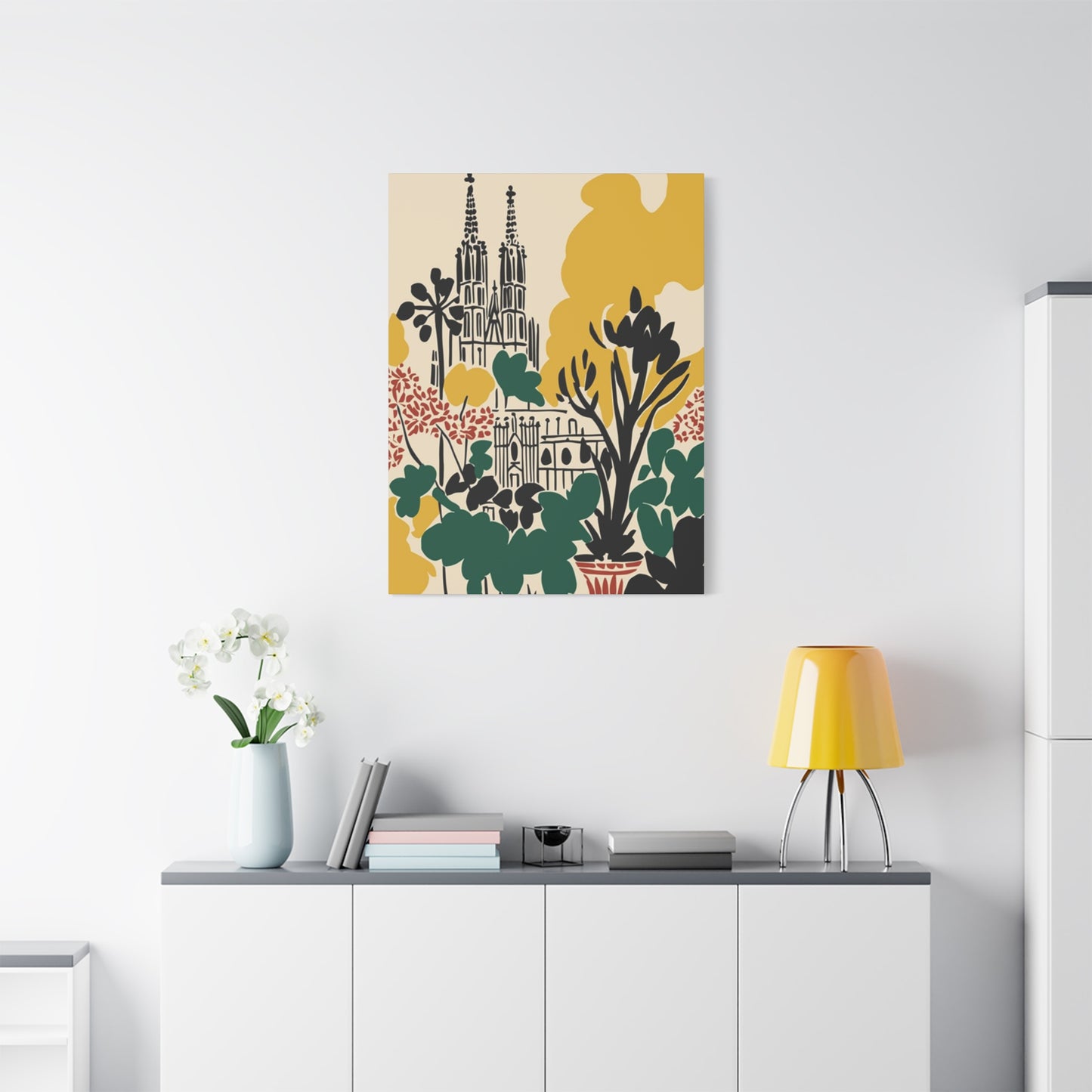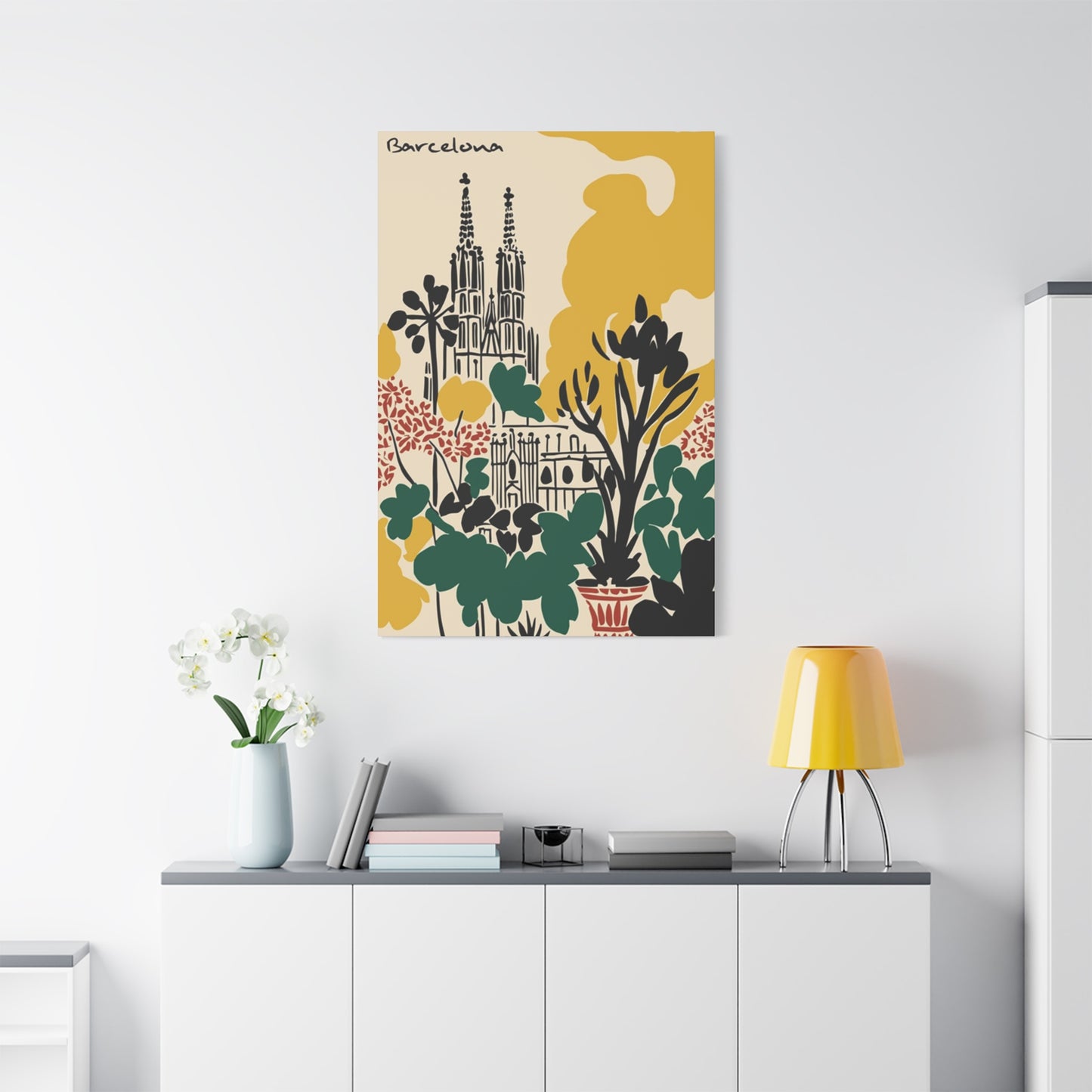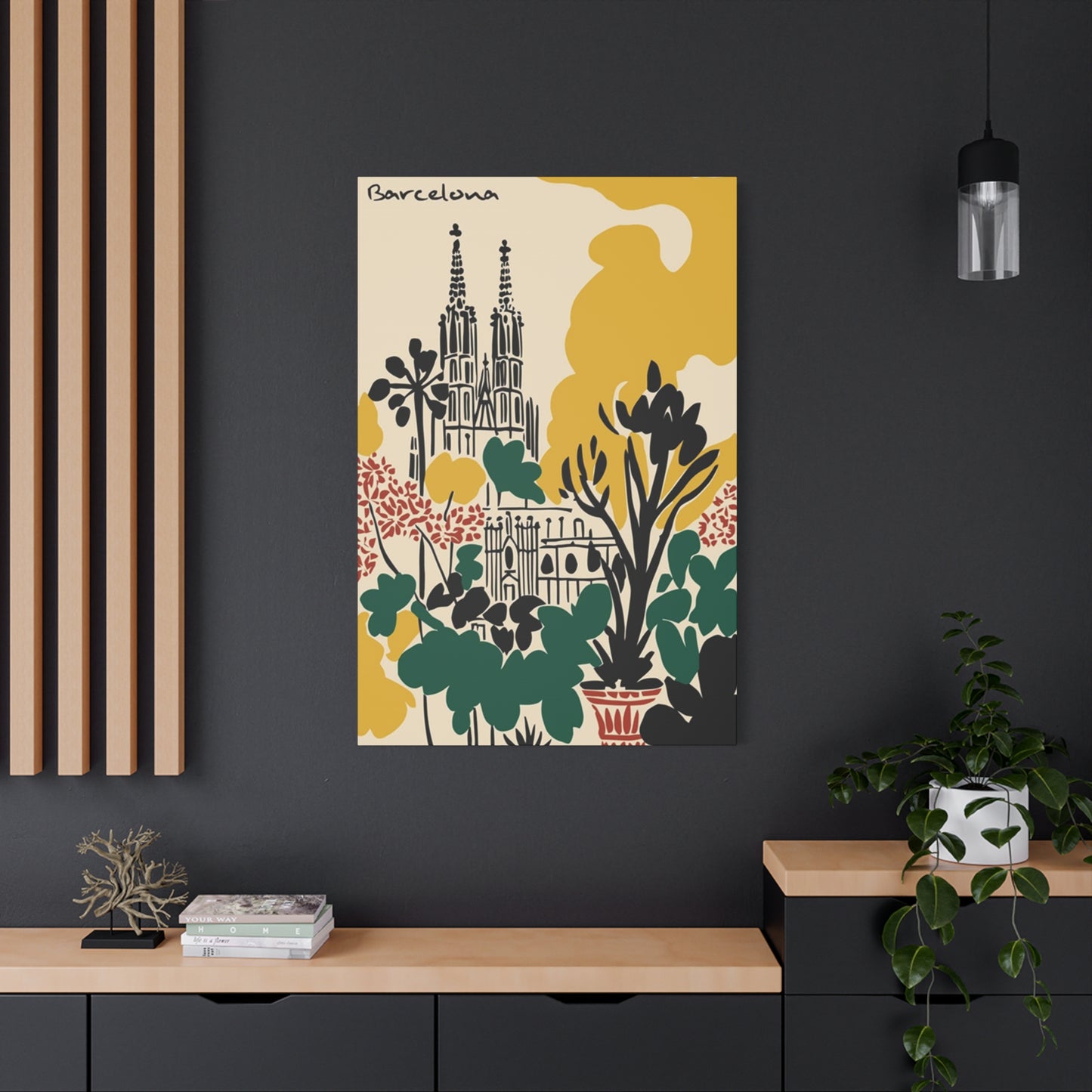Barcelona's Artistic Soul: Abstract Wall Art Inspired by Catalonia's Cultural Capital
Barcelona stands as one of Europe's most vibrant artistic destinations, where centuries of cultural heritage blend seamlessly with contemporary creativity. This Catalan metropolis has inspired countless artists throughout history, from Antoni Gaudí's architectural masterpieces to Pablo Picasso's revolutionary paintings. Today, Barcelona continues to influence modern abstract art, offering endless inspiration for artists who seek to capture the essence of this Mediterranean jewel through non-representational forms, bold colors, and innovative compositions.
The city's unique character emerges through its distinctive neighborhoods, each telling its own story through architecture, street life, and cultural expression. From the Gothic Quarter's medieval stones to the modernist facades of the Eixample district, Barcelona presents a visual feast that translates beautifully into abstract artistic interpretations. The interplay of light and shadow across ancient buildings, the rhythm of daily life in bustling plazas, and the Mediterranean's azure waters all contribute to a rich palette that abstract artists draw upon when creating works inspired by this magnificent city.
Abstract art inspired by Barcelona captures more than mere visual elements; it embodies the spirit of a city that has always embraced innovation while honoring its past. The artistic movement that emerges from Barcelona's influence speaks to universal themes of creativity, passion, and cultural identity, making these works appealing to art enthusiasts worldwide who seek to bring a piece of Catalonia's artistic energy into their living spaces.
Barcelona Beach and Coastal Abstract Expressions
The Mediterranean coastline that embraces Barcelona provides endless inspiration for abstract artists seeking to capture the essence of sun, sea, and sand through non-representational forms. These coastal-inspired pieces translate the rhythmic motion of waves, the interplay of light on water, and the warm tones of Barcelona's famous beaches into dynamic abstract compositions that evoke the sensory experience of spending time along this stunning shoreline.
Barcelona's beaches, from the popular Barceloneta to the quieter stretches of Bogatell and Mar Bella, offer distinct moods and atmospheres that abstract artists interpret through varying color palettes and compositional approaches. The morning light casting golden reflections across calm waters might inspire gentle, flowing abstract forms in warm ochres and soft blues, while the energetic afternoon beach scene with its vibrant umbrellas, active beachgoers, and sparkling waves could translate into bold, geometric abstractions featuring dynamic movement and vivid color contrasts.
The urban beach concept that Barcelona pioneered creates a unique artistic opportunity where city meets sea, modernity encounters nature, and architectural lines intersect with organic coastline curves. Abstract artists draw inspiration from this juxtaposition, creating works that incorporate both the structured elements of the city's waterfront development and the free-flowing natural forms of the Mediterranean environment. These pieces often feature layered compositions that suggest depth and movement, mimicking the way Barcelona's cityscape gradually transitions into the coastal landscape.
Textural elements play a crucial role in beach-inspired Barcelona abstracts, with artists employing various techniques to suggest the tactile qualities of sand, the smoothness of worn pebbles, and the fluidity of seawater. Mixed media approaches incorporating actual sand, crushed shells, or metallic elements that catch light like sun on water create multi-dimensional artworks that engage viewers on both visual and tactile levels.
The color psychology of Barcelona's coastal abstracts typically emphasizes the therapeutic and calming qualities associated with beach environments while maintaining the energy and vibrancy characteristic of this cosmopolitan city. Blues ranging from deep navy to bright turquoise represent the various moods of the Mediterranean, while warm yellows, oranges, and terra cotta tones echo the sunlit sand and the city's distinctive architectural palette.
Seasonal variations in Barcelona's coastal environment provide additional layers of inspiration for abstract artists. Summer pieces might explode with saturated colors and dynamic energy, reflecting the bustling beach life and intense Mediterranean sun. Autumn and winter coastal abstracts could explore more subdued palettes and contemplative compositions, capturing the peaceful beauty of Barcelona's beaches during quieter months when the interplay of light and water takes on a different, more introspective quality.
Contemporary Barcelona coastal abstracts often incorporate elements of environmental consciousness, with artists using their work to comment on the relationship between urban development and natural preservation. These pieces might feature contrasting areas of pure, natural-inspired forms alongside more industrial or geometric elements, creating visual dialogues about sustainability and the future of coastal cities like Barcelona.
The scale and format of beach-inspired Barcelona abstracts can vary dramatically, from intimate pieces that invite close contemplation to large-scale works that immerse viewers in the expansive feeling of standing before the Mediterranean horizon. Gallery walls and private collections worldwide showcase these coastal abstractions, bringing the essence of Barcelona's maritime character into diverse interior spaces and cultural contexts.
Park Güell's Whimsical Abstract Interpretations
Park Güell represents one of Barcelona's most distinctive landmarks, where Antoni Gaudí's visionary architecture creates a dreamlike landscape that has inspired countless abstract artistic interpretations. The park's organic forms, vibrant mosaic work, and integration with the natural hillside environment provide rich source material for artists seeking to capture its magical essence through non-representational art forms that emphasize color, texture, and imaginative composition.
Gaudí's use of trencadís, the broken tile mosaic technique that decorates many of Park Güell's surfaces, translates beautifully into abstract art through fragmented color fields, collage-like compositions, and layered textural approaches. Artists inspired by this technique create works that celebrate the beauty of broken and reassembled elements, finding new harmonies in seemingly disparate pieces that come together to form unified artistic statements reminiscent of the park's iconic benches, columns, and architectural details.
The serpentine bench that winds along the main terrace of Park Güell offers particular inspiration for abstract artists interested in flowing, organic forms that seem to grow naturally from their environment. These undulating lines appear in abstract paintings as rhythmic brushstrokes, curved compositional elements, and flowing color transitions that capture the bench's invitation to rest and contemplate while enjoying panoramic views of Barcelona spread below.
Color plays a central role in Park Güell-inspired abstracts, with artists drawing from the park's rich palette of blues, greens, yellows, and earth tones that Gaudí incorporated into his mosaic work. These colors often appear in unexpected combinations and intensities, reflecting how the park's design challenges conventional aesthetic expectations while creating harmonious overall effects that feel both surprising and inevitable.
The architectural elements of Park Güell, from the iconic entrance pavilions with their fairy-tale rooflines to the forest of tilted columns in the Hypostyle Room, provide geometric and structural inspiration for abstract artists who translate these forms into purely aesthetic compositions. The interplay between curved and angular elements, the rhythm of repeated architectural motifs, and the integration of structural and decorative functions all find expression in abstract works that capture the park's architectural poetry.
Natural elements within Park Güell, including the Mediterranean vegetation, the rocky terrain, and the integration of existing trees into Gaudí's design, inspire abstract artists to explore themes of harmony between human creativity and natural environment. These works often feature organic shapes that seem to grow from the canvas, earth-toned palettes that reference the park's hillside setting, and compositional approaches that suggest the careful balance Gaudí achieved between built and natural elements.
The panoramic views from Park Güell, encompassing Barcelona's urban landscape, the Mediterranean Sea, and the surrounding Catalonian countryside, inspire abstract artists to create works that capture the sensation of elevated perspective and expanded vision. These pieces might employ aerial viewpoints, horizon-line compositions, and color gradations that suggest the atmospheric effects visible from the park's elevated terraces.
Light and shadow patterns created by Park Güell's unique architectural forms provide additional inspiration for abstract artists interested in exploring how built environments can create ever-changing visual experiences throughout the day. Morning light filtering through the columned halls, afternoon shadows cast by curved rooflines, and evening illumination highlighting mosaic details all translate into abstract compositions that celebrate the dynamic relationship between architecture and natural light.
The playful, almost childlike quality that characterizes much of Park Güell's design encourages abstract artists to embrace experimentation, whimsy, and joy in their creative processes. These works often display a sense of freedom and imagination that reflects Gaudí's own approach to architectural design, where practical considerations never overshadowed the pursuit of beauty and wonder.
Contemporary abstract artists continue to find new ways to interpret Park Güell's influence, sometimes incorporating actual materials reminiscent of Gaudí's techniques, such as broken ceramic pieces, colored glass, or mixed media approaches that create textural surfaces echoing the park's tactile richness. These modern interpretations maintain the spirit of innovation and creativity that Gaudí embodied while translating his architectural vision into purely artistic expression.
Sacred Architecture in Abstract Form: Sagrada Família Inspirations
The Sagrada Família basilica stands as Barcelona's most iconic architectural achievement and continues to serve as a profound source of inspiration for abstract artists who seek to capture the spiritual and artistic essence of Antoni Gaudí's masterpiece through non-representational artistic expressions. This ongoing architectural project, which combines Gothic and Art Nouveau forms with Gaudí's unique naturalistic style, offers endless possibilities for abstract interpretation through its complex geometries, organic forms, and spiritual symbolism.
The basilica's famous facades, each telling different aspects of the Christian story through stone carving and architectural narrative, inspire abstract artists to explore themes of storytelling through pure form, color, and composition. The Nativity Facade's exuberant celebration of life and growth translates into abstract works featuring upward-reaching forms, organic curves, and warm, life-affirming color palettes that suggest emergence, birth, and natural development without literal representation.
The Passion Facade's more angular, austere approach to depicting suffering and sacrifice provides inspiration for abstract compositions that explore contrast, tension, and emotional intensity through stark geometric forms, dramatic color juxtapositions, and compositional elements that create visual dialogue about struggle and transcendence. These works often feature strong vertical or diagonal elements that create dynamic tension while maintaining overall compositional balance.
Inside the basilica, the forest-like columns that branch toward the ceiling like trees create one of the most distinctive architectural spaces in the world, inspiring abstract artists to explore themes of organic growth, natural structure, and the relationship between earth and sky. These column-inspired abstracts often feature branching forms, tree-like silhouettes, and upward movement that captures the sensation of standing within Gaudí's architectural forest while translating this experience into purely aesthetic terms.
The play of light through the Sagrada Família's stained glass windows creates ever-changing patterns of color and illumination that abstract artists interpret through dynamic color field paintings, light-inspired compositions, and works that explore the temporal nature of illumination and shadow. These pieces often feature gradations of color that shift across the composition, mimicking how natural light transforms the basilica's interior atmosphere throughout the day.
The mathematical precision underlying Gaudí's organic forms provides inspiration for abstract artists interested in the intersection of geometric order and natural appearance. The ruled surfaces, hyperbolic paraboloids, and other complex geometric forms that structure the Sagrada Família's design translate into abstract compositions that explore how mathematical relationships can create visually compelling and emotionally resonant artistic expressions.
The ongoing construction of the Sagrada Família, expected to continue for several more decades, inspires abstract artists to create works that explore themes of process, development, and the relationship between human aspiration and patient creation. These pieces might incorporate layered approaches that suggest work in progress, unfinished edges that invite completion in the viewer's imagination, or compositions that balance completed and developing areas.
The spiritual dimension of the Sagrada Família provides abstract artists with opportunities to explore transcendent themes through pure artistic means, creating works that evoke feelings of awe, contemplation, and connection to something greater than everyday experience. These spiritually-inspired abstracts often employ upward-reaching compositions, luminous color palettes, and forms that suggest movement beyond the physical realm.
The international recognition and cultural significance of the Sagrada Família make abstract works inspired by this architectural marvel particularly appealing to collectors and art enthusiasts worldwide who appreciate both Barcelona's cultural heritage and contemporary artistic expression. These pieces serve as bridges between Gaudí's architectural genius and current abstract art movements, maintaining relevance across different cultural and temporal contexts.
The scale and ambition of the Sagrada Família project inspire abstract artists to approach their own work with similar dedication to vision and long-term artistic development. Many artists create series of works exploring different aspects of the basilica's influence, developing their interpretations over time in ways that parallel the ongoing construction of Gaudí's architectural masterpiece.
Contemporary abstract artists continue to find new ways to engage with the Sagrada Família's influence, sometimes incorporating architectural drawing techniques, construction-inspired materials, or collaborative approaches that reflect the collective effort required to complete Gaudí's vision. These modern interpretations maintain the innovative spirit that characterizes both the basilica itself and Barcelona's continuing tradition of artistic experimentation.
Urban Mapping in Abstract Expression
Barcelona's distinctive urban layout, characterized by the Eixample district's grid pattern, the medieval streets of the Gothic Quarter, and the organic development of neighborhoods like Gràcia and Sarrià, provides rich inspiration for abstract artists who translate the city's geographic and social geography into non-representational artistic expressions. These urban mapping abstracts capture the rhythm, flow, and character of Barcelona's streets while transforming literal cartographic information into purely aesthetic experiences.
The famous grid system of the Eixample, designed by Ildefons Cerdà in the 19th century, offers geometric inspiration for abstract artists who explore themes of urban planning, social organization, and the relationship between rational design and lived experience. These grid-inspired abstracts might feature repetitive geometric elements, modular compositions, and systematic color applications that reference the district's organized layout while maintaining artistic freedom and individual expression.
The contrast between the Eixample's geometric order and the organic, medieval street pattern of the Gothic Quarter provides abstract artists with opportunities to explore visual dialogues between different approaches to urban development and cultural evolution. These contrastive works often feature areas of geometric precision alongside more organic, flowing forms that suggest the historical layering that characterizes Barcelona's urban development over centuries.
Street intersections, plazas, and public spaces throughout Barcelona inspire abstract compositions that capture the social energy and cultural vitality of urban gathering places. These intersection-inspired works might employ radiating forms, convergent lines, and areas of concentrated activity that translate the feeling of standing in places like Plaça Catalunya, Plaça Sant Jaume, or the many neighborhood squares that punctuate Barcelona's urban fabric.
The relationship between Barcelona's urban layout and its natural geography, including the Mediterranean coastline, the Collserola hills, and the rivers that historically shaped the city's development, appears in abstract works that explore themes of human settlement within natural landscapes. These geographically-inspired abstracts often feature flowing forms that suggest water courses, elevated areas that reference the city's hills, and coastal elements that acknowledge Barcelona's maritime orientation.
Transportation networks, including Barcelona's extensive metro system, bus routes, and bike paths, provide linear inspiration for abstract artists who translate the city's mobility infrastructure into dynamic compositional elements. These transportation-inspired abstracts might feature flowing lines that suggest movement and connection, network-like patterns that reference the metro map, or rhythmic elements that capture the pulse of urban transit systems.
The color coding and wayfinding systems used throughout Barcelona's urban environment inspire abstract artists to explore how color can convey information, create mood, and establish visual hierarchy within artistic compositions. Metro line colors, neighborhood character distinctions, and architectural material palettes all contribute to abstract works that reference urban color systems while maintaining purely aesthetic purposes.
Neighborhood boundaries and district characteristics provide inspiration for abstract artists who create works that capture the distinct personality of different areas within Barcelona. A Poble Sec-inspired abstract might emphasize earthy, residential qualities, while a Born district piece could feature more dynamic, culturally active visual elements that reflect the neighborhood's artistic and nightlife energy.
The layered history visible throughout Barcelona's urban landscape, where Roman foundations, medieval structures, modernist buildings, and contemporary architecture coexist, inspires abstract artists to create works that explore temporal layering, historical continuity, and urban palimpsest. These historically-layered abstracts often employ techniques that suggest archaeological stratification, architectural evolution, and cultural continuity across different time periods.
Urban density variations throughout Barcelona, from the compact medieval core to the more spacious residential areas in the upper reaches of the city, provide inspiration for abstract compositions that explore themes of concentration, expansion, and spatial rhythm. These density-inspired works might feature areas of intense activity alongside more open, contemplative spaces that reflect the varied urban experiences available within the city.
The integration of green spaces within Barcelona's urban fabric, including parks, tree-lined streets, and rooftop gardens, inspires abstract artists to create works that explore the relationship between built and natural environments within cities. These green-space-inspired abstracts often feature organic forms that interrupt or complement geometric urban elements, suggesting the importance of nature within urban planning and daily city life.
Contemporary urban challenges and opportunities in Barcelona, including sustainability initiatives, smart city technologies, and adaptive reuse of historical buildings, inspire abstract artists to create works that explore themes of urban evolution, environmental responsibility, and the future of city living. These forward-looking abstracts often incorporate innovative materials, interactive elements, or compositional approaches that suggest the continuing evolution of urban artistic expression.
Vibrant Color Expressions of Catalonian Culture
The distinctive color palette that characterizes Barcelona and Catalonia more broadly provides rich inspiration for abstract artists who seek to capture the region's cultural essence through bold, expressive color relationships that transcend literal representation while maintaining strong connections to place and tradition. These vibrant abstracts draw from multiple sources of Catalonian color heritage, including traditional festivals, architectural elements, textile traditions, and the Mediterranean landscape's natural hues.
The colors of Catalonian festivals, particularly those associated with celebrations like Sant Jordi, La Mercè, and neighborhood festa majors, inspire abstract artists to create works that pulse with celebratory energy and community spirit. These festival-inspired abstracts often feature explosive color combinations that reference fireworks displays, traditional costume elements, and the decorative materials used to transform Barcelona's streets during major celebrations.
Traditional Catalonian textile patterns, including those found in historical fabrics, contemporary fashion, and decorative arts, provide abstract artists with systematic approaches to color combination and pattern development that maintain cultural resonance while serving purely aesthetic purposes. These textile-inspired abstracts might employ repetitive color motifs, geometric pattern structures, or fabric-like compositional approaches that reference the region's rich tradition of decorative arts.
The architectural color palette that characterizes Barcelona's buildings, from the warm ochres and terra cottas of medieval structures to the bold color applications found in modernist and contemporary architecture, offers abstract artists a sophisticated range of hues that immediately evoke the city's visual character. These architecturally-inspired color abstracts often feature earth-based palettes punctuated by more saturated accent colors that reference decorative architectural elements.
Mediterranean vegetation surrounding Barcelona, including olive trees, pine forests, vineyard landscapes, and coastal flora, contributes natural color inspiration that abstract artists interpret through organic color relationships and seasonal color variations. These botanically-inspired abstracts might explore the silver-green of olive leaves, the deep green of Mediterranean pines, or the golden hues of autumn vineyard landscapes that characterize the Catalonian countryside.
The distinctive light quality of the Mediterranean climate creates atmospheric effects that inspire abstract artists to explore how environmental conditions affect color perception and emotional response. Barcelona's clear, bright light tends to intensify colors and create sharp contrasts, leading to abstract works that celebrate saturated hues and dramatic color juxtapositions that capture the feeling of Mediterranean illumination.
Traditional Catalonian ceramic traditions, visible in everything from decorative tiles to pottery and sculptural works, provide abstract artists with color combinations and surface treatments that reference the region's long history of ceramic artistry. These ceramic-inspired abstracts might employ earth-based glazes, metallic accents, or textural approaches that evoke the tactile qualities of traditional Catalonian pottery.
The colors associated with Catalonian political and cultural identity, including the distinctive red and yellow stripes of the Catalonian flag, inspire abstract artists to create works that explore themes of regional identity, cultural pride, and political expression through color relationships that transcend literal flag representation while maintaining symbolic resonance.
Food culture in Barcelona and Catalonia provides unexpected color inspiration through the vibrant hues found in local markets, traditional dishes, and seasonal produce. The deep purples of eggplants, the bright reds of tomatoes, the golden yellows of saffron, and the varied greens of market vegetables all contribute to abstract color palettes that reference the region's rich culinary traditions.
Seaside color variations, from the deep blues of the Mediterranean to the lighter aquas of shallow coastal waters, the warm beiges of sand, and the weathered colors of maritime infrastructure, inspire abstract artists to create coastal color abstracts that capture Barcelona's relationship with the sea through color relationships rather than literal representation.
The interplay between historic and contemporary color applications throughout Barcelona, where medieval stone colors meet modern architectural materials, traditional decorative schemes encounter contemporary design approaches, and historical color traditions adapt to current aesthetic sensibilities, provides abstract artists with opportunities to explore temporal color relationships and cultural evolution through purely aesthetic means.
Seasonal color changes in Barcelona's urban and natural environments, from the fresh greens of spring to the intense heat colors of summer, the warm transitions of autumn, and the subtle variations of the mild Mediterranean winter, inspire abstract artists to create works that capture the temporal dimension of place-based color experience while maintaining year-round visual appeal for diverse interior environments.
Bold Brushwork Techniques in Barcelona-Inspired Abstracts
The dynamic energy and passionate artistic tradition of Barcelona inspire abstract artists to employ bold, expressive brushwork techniques that capture the city's creative vitality through gestural painting approaches, dramatic mark-making, and confident color application. These technique-focused abstracts prioritize the physical act of painting and the emotional expression possible through direct, unmediated artistic gesture while drawing inspiration from Barcelona's artistic heritage and contemporary cultural energy.
The tradition of expressive mark-making visible in Barcelona's street art and murals provides contemporary abstract artists with examples of bold, public-facing artistic gesture that prioritizes immediate visual impact and emotional communication. These street art-inspired abstracts often feature large-scale brushstrokes, dramatic color contrasts, and confident mark-making that translates the energy of public art creation into gallery and residential contexts.
The influence of artists like Pablo Picasso, who spent formative years in Barcelona, continues to inspire abstract artists who employ bold, experimental brushwork techniques that prioritize artistic innovation and expressive freedom over conventional technical approaches. These Picasso-influenced abstracts might feature fragmented brushstrokes, experimental color applications, and compositional approaches that reflect the revolutionary spirit that characterized Barcelona's artistic scene during Picasso's residence.
The Mediterranean tradition of fresco painting, visible in many of Barcelona's historical buildings and religious sites, provides technical inspiration for abstract artists who explore how bold, direct color application can create lasting artistic impact. These fresco-inspired abstracts often feature confident color blocking, simplified compositional approaches, and brushwork techniques that reference the directness required in traditional fresco painting.
Contemporary Barcelona's vibrant art scene, including numerous galleries, art fairs, and public art initiatives, encourages abstract artists to develop bold, distinctive artistic voices that can command attention in competitive cultural environments. These contemporary-inspired abstracts often feature innovative brushwork techniques, experimental material applications, and confident compositional approaches that reflect the current artistic energy of Barcelona's cultural scene.
The architectural boldness visible throughout Barcelona, from Gaudí's innovative construction techniques to contemporary architectural projects, inspires abstract artists to approach their brushwork with similar confidence and willingness to experiment with unconventional techniques. These architecture-inspired brushwork abstracts might feature structural mark-making, building-like compositional approaches, or brushwork that suggests architectural construction processes.
The physical geography surrounding Barcelona, including dramatic coastal cliffs, rolling hills, and mountainous terrain, provides inspiration for abstract artists who translate these landscape features into bold gestural painting that captures the physical energy of the natural environment through direct brushwork rather than representational imagery.
Traditional Catalonian dance and music traditions, characterized by energetic movement and rhythmic patterns, inspire abstract artists to create works that capture musical and kinetic energy through rhythmic brushwork, repeated gestural elements, and compositional approaches that suggest movement and temporal development. These performance-inspired abstracts often feature flowing brushstrokes that seem to dance across the canvas surface.
The artisan traditions visible throughout Barcelona, from traditional crafts to contemporary design work, provide examples of confident, skilled hand-work that abstract artists translate into painting techniques that celebrate manual dexterity and artistic craftsmanship. These craft-inspired brushwork abstracts often feature visible tool marks, textural surface treatments, and evidence of the artist's physical engagement with materials.
The emotional intensity associated with Barcelona's cultural and political history, including struggles for independence, artistic innovation, and cultural preservation, inspires abstract artists to employ brushwork techniques that convey passion, commitment, and expressive urgency. These historically-inspired abstracts often feature dramatic gestural elements, emotionally-charged color applications, and brushwork that seems to emerge from deep personal and cultural conviction.
The Mediterranean lifestyle's emphasis on sensual pleasure, outdoor living, and appreciation for physical beauty translates into brushwork approaches that celebrate the tactile aspects of painting, the sensual qualities of color and texture, and the physical pleasure available through direct artistic creation. These lifestyle-inspired abstracts often feature flowing, organic brushwork that suggests ease, pleasure, and appreciation for material beauty.
Contemporary art education institutions in Barcelona, including prestigious schools and workshops that attract international students, contribute to an environment where experimental brushwork techniques are constantly being developed and refined. These educationally-inspired abstracts often feature technically sophisticated approaches to mark-making, innovative tool usage, and brushwork that reflects current developments in abstract painting techniques.
The collaboration between traditional artistic techniques and contemporary innovation that characterizes much of Barcelona's current art scene inspires abstract artists to develop brushwork approaches that honor historical painting traditions while pushing toward new forms of artistic expression. These tradition-innovation synthesis abstracts often feature classical brushwork techniques applied to contemporary compositional approaches, creating works that feel both timeless and current.
Dusk and Evening Light Interpretations
The distinctive quality of evening light in Barcelona, influenced by the city's Mediterranean location, architectural character, and relationship to both sea and mountains, provides profound inspiration for abstract artists who seek to capture the magical transition from day to night through color, atmosphere, and compositional approaches that evoke the emotional and visual experience of Barcelona's legendary sunsets and evening illumination.
Barcelona's position on the Mediterranean coast creates evening light conditions that abstract artists interpret through warm color palettes featuring deep oranges, rich purples, and golden yellows that reference the spectacular sunsets visible from the city's beaches, elevated neighborhoods, and architectural vantage points. These sunset-inspired abstracts often feature horizontal compositional elements that suggest horizon lines while maintaining purely abstract visual relationships.
The way evening light interacts with Barcelona's diverse architectural surfaces, from medieval stone that glows warmly at sunset to modern glass facades that reflect the changing sky, inspires abstract artists to create works that explore how light transforms material appearance and creates atmospheric effects. These architecture-light interaction abstracts might feature reflective surface treatments, color gradations that suggest changing illumination, and compositional approaches that reference the vertical rhythms of urban skylines.
The golden hour photography that Barcelona's evening light makes possible inspires abstract artists to explore similar warm, enveloping color relationships and soft atmospheric effects that capture the romantic and contemplative mood associated with late afternoon and early evening in Mediterranean cities. These golden hour abstracts often feature luminous color applications, soft edge treatments, and overall atmospheric approaches that evoke the gentle, flattering quality of Barcelona's evening illumination.
Street lighting and architectural illumination throughout Barcelona create evening cityscapes that inspire abstract artists to explore artificial light sources, dramatic contrast relationships, and the interplay between warm artificial lighting and cooler evening sky colors. These urban evening light abstracts might feature punctual bright areas surrounded by darker passages, creating rhythmic light patterns that reference the city's nighttime illumination without literal representation.
The social and cultural activities that characterize Barcelona's evening life, from outdoor dining to street performances and evening strolls, inspire abstract artists to create works that capture the energy and warmth of Mediterranean evening culture through dynamic color relationships and compositional approaches that suggest gathering, celebration, and social connection.
The transition from the bright, clear light of Mediterranean day to the softer, more romantic atmosphere of evening provides abstract artists with opportunities to explore temporal change, atmospheric transformation, and the emotional shifts associated with different times of day. These time-transition abstracts often feature gradual color changes, shifting atmospheric effects, and compositional elements that suggest the passage of time.
The view of evening light from Barcelona's elevated areas, including Park Güell, Montjuïc, and the various miradors throughout the city, inspires abstract artists to create works that capture the expansive feeling of elevated perspective combined with the atmospheric effects of evening illumination spreading across the urban landscape. These elevated evening view abstracts often feature panoramic compositional approaches and atmospheric color treatments.
The reflection of evening light on Barcelona's harbor and Mediterranean waters creates shimmering, ever-changing visual effects that abstract artists interpret through dynamic surface treatments, reflective color applications, and compositional approaches that suggest the movement and fluidity of light on water. These water-light reflection abstracts often feature vertical compositional elements that reference the way light creates columns of reflection on water surfaces.
The interplay between natural evening light and the illuminated interiors of Barcelona's many cafes, restaurants, and cultural venues creates visual contrasts that inspire abstract artists to explore themes of interior and exterior space, private and public experience, and the relationship between domestic and urban illumination. These interior-exterior light contrast abstracts might feature warm and cool color juxtapositions that reference these lighting relationships.
Seasonal variations in Barcelona's evening light, from the long summer evenings with extended golden hour periods to the earlier sunsets of winter that create different atmospheric conditions, provide abstract artists with varying inspiration throughout the year. These seasonal evening light abstracts might explore different color palettes, atmospheric conditions, and emotional moods associated with various times of year.
The romantic associations of evening light in Barcelona, reinforced by the city's reputation as a destination for couples and its numerous romantic venues, inspire abstract artists to create works that evoke intimacy, romance, and emotional connection through soft color relationships, atmospheric treatments, and compositional approaches that suggest closeness and shared experience.
Contemporary photography and digital art that captures Barcelona's evening light provides additional inspiration for abstract artists who translate photographic effects, digital color manipulation, and contemporary visual media approaches into traditional painting and drawing techniques, creating works that bridge historical abstract art traditions with current visual culture.
Geometric Abstraction Inspired by Catalonian Design
The rich tradition of geometric design visible throughout Barcelona and Catalonia, spanning from medieval architectural patterns to modernist innovations and contemporary design excellence, provides extensive inspiration for abstract artists who create works that explore geometric relationships, mathematical precision, and systematic visual organization while maintaining artistic expressiveness and cultural resonance with Catalonian design heritage.
Medieval geometric patterns visible in Barcelona's Gothic Quarter, including window tracery, floor mosaics, and architectural ornamentation, inspire contemporary abstract artists to explore how historical geometric systems can inform current artistic practice. These medieval-inspired geometric abstracts often feature intricate pattern work, systematic repetition, and mathematical relationships that reference historical design principles while serving purely aesthetic contemporary purposes.
The modernist movement that flourished in Barcelona during the late 19th and early 20th centuries, including work by Antoni Gaudí, Josep Puig i Cadafalch, and other architectural innovators, created geometric innovations that continue to inspire abstract artists interested in the relationship between mathematical precision and organic expression. These modernist-inspired geometric abstracts might feature curved geometric forms, systematic pattern variations, and geometric relationships that seem to grow organically rather than being imposed artificially.
Contemporary Catalonian design excellence, visible in everything from furniture design to graphic design and architectural projects, provides abstract artists with examples of how geometric principles can be applied to create works that feel both systematic and expressive, ordered and creative. These contemporary design-inspired abstracts often feature clean geometric relationships, sophisticated color applications, and compositional approaches that reflect current design sensibilities.
The tradition of ceramic tile work that characterizes much of Barcelona's architectural decoration, from simple geometric patterns to complex systematic designs, inspires abstract artists to explore modular composition, repetitive pattern work, and the relationship between individual elements and overall systematic organization. These tile-inspired geometric abstracts might feature grid-based compositions, modular color applications, and systematic approaches to pattern development.
Islamic geometric traditions that influenced medieval Iberian design and continue to appear in Barcelona's decorative arts provide abstract artists with sophisticated mathematical systems for creating complex visual patterns that maintain perfect geometric relationships while creating rich, contemplative visual experiences. These Islamic-influenced geometric abstracts often feature intricate interlocking patterns, systematic symmetry, and mathematical precision that creates meditative visual effects.
The influence of industrial design and manufacturing that has characterized Barcelona's economic development provides inspiration for geometric abstracts that explore themes of precision, systematic production, and the aesthetic possibilities available through mechanical accuracy and systematic repetition. These industrial-inspired geometric abstracts might feature machine-like precision, systematic color applications, and compositional approaches that reference manufacturing processes.
Traditional Catalonian textile patterns, particularly those found in historical fabrics and contemporary fashion design, provide geometric inspiration through systematic pattern repetition, color organization, and the relationship between individual motifs and overall textile design. These textile-inspired geometric abstracts often feature fabric-like pattern systems, repetitive geometric motifs, and color relationships that reference traditional textile design principles.
The mathematical principles underlying much of Barcelona's most celebrated architecture, including the geometric systems that Gaudí employed in projects like the Sagrada Família and Casa Milà, inspire abstract artists to explore how mathematical relationships can create visually compelling and emotionally resonant artistic experiences. These mathematically-inspired geometric abstracts often feature complex geometric relationships that create surprising visual effects despite systematic underlying organization.
Street and plaza paving patterns throughout Barcelona, from simple geometric arrangements to complex systematic designs that organize public space, inspire abstract artists to create works that explore how geometric organization can create spatial experience and visual rhythm. These paving-inspired geometric abstracts might feature modular composition, systematic repetition, and geometric relationships that reference urban design principles.
The relationship between geometric organization and natural forms that characterizes much of Catalonian design tradition inspires abstract artists to create works that explore how systematic geometric approaches can accommodate organic variation and natural irregularity. These nature-geometry synthesis abstracts often feature geometric systems that seem to grow organically or natural forms that reveal underlying geometric organization.
Contemporary digital design tools and techniques that Barcelona's design community employs to create sophisticated geometric work provide abstract artists with new possibilities for systematic design development, precise geometric relationships, and complex pattern generation that can be translated into traditional artistic media. These digitally-inspired geometric abstracts often feature systematic precision, complex pattern relationships, and geometric sophistication that reflects current technological capabilities.
The educational tradition that has made Barcelona a center for design education, including institutions that teach systematic approaches to geometric design and pattern development, contributes to an environment where geometric abstraction can be both technically sophisticated and artistically expressive. These educationally-inspired geometric abstracts often feature theoretical rigor combined with expressive freedom, creating works that demonstrate both geometric knowledge and artistic creativity.
Approaches to Barcelona's Urban Energy
The vibrant, sometimes intense urban energy that characterizes life in Barcelona provides rich inspiration for abstract artists working in expressionist modes that prioritize emotional communication, gestural freedom, and the translation of urban psychological states into purely artistic form. These expressionist abstracts capture the excitement, complexity, and occasional overwhelming nature of city life while maintaining the optimistic, life-affirming character that distinguishes Barcelona from other major urban centers.
The density and diversity of human activity visible throughout Barcelona's public spaces, from the crowded thoroughfares of Las Ramblas to the intimate neighborhood plazas where daily life unfolds, inspire expressionist abstracts that capture the psychological experience of urban social immersion through aggressive brushwork, intense color relationships, and compositional approaches that suggest crowd energy and social interaction.
Barcelona's reputation as a city that never sleeps, with active street life continuing well into the night, provides inspiration for expressionist artists who explore themes of urban vitality, social energy, and the psychological effects of constant stimulation and activity. These nightlife-inspired expressionist abstracts often feature dark backgrounds punctuated by intense color bursts, suggesting the energy and excitement of Barcelona's famous nightlife scene.
Conclusion
Barcelona's Artistic Soul: Abstract Wall Art Inspired by Catalonia's Cultural Capital captures the vibrant energy, creativity, and rich cultural heritage of one of the world’s most dynamic cities. Through bold shapes, vivid colors, and imaginative compositions, these artworks reinterpret the essence of Barcelona—its iconic architecture, bustling streets, and artistic spirit—into contemporary abstract forms. Each piece serves as a visual celebration of Catalonia’s cultural identity, offering viewers a unique way to experience the city’s charm and dynamism without leaving their interior space. This type of wall art appeals to art enthusiasts, travel lovers, and interior designers seeking to merge cultural storytelling with modern décor.
Incorporating Barcelona-inspired abstract wall art into interiors allows homeowners and designers to create spaces that are energetic, sophisticated, and culturally enriched. In living rooms, offices, or creative studios, these pieces act as captivating focal points, drawing attention and sparking conversation. They convey a sense of movement, rhythm, and urban vitality, infusing spaces with the same vibrancy that characterizes Barcelona itself. The versatility of abstract forms ensures these artworks complement a wide range of décor styles—from modern minimalist and industrial to eclectic or bohemian interiors—adding both color and conceptual depth to any room.
The artistry behind this wall art emphasizes abstraction, composition, and emotion. Artists translate the architectural marvels of Gaudí, the lively streets, and the artistic atmosphere into dynamic visual expressions, using layers, textures, and contrasting hues to evoke the city’s multifaceted character. This approach transforms each piece into more than decoration—it becomes an immersive experience that invites viewers to explore Barcelona’s cultural soul through a contemporary artistic lens.
Ultimately, Barcelona's Artistic Soul: Abstract Wall Art elevates interiors by merging cultural heritage with modern aesthetic expression. It transforms walls into platforms for creativity, inspiration, and storytelling, allowing individuals to celebrate Barcelona’s vibrant energy while enhancing the visual appeal of their spaces. By featuring this artwork, interiors gain sophistication, cultural resonance, and a sense of dynamic movement, making it a timeless and captivating addition to any home, office, or gallery.

















